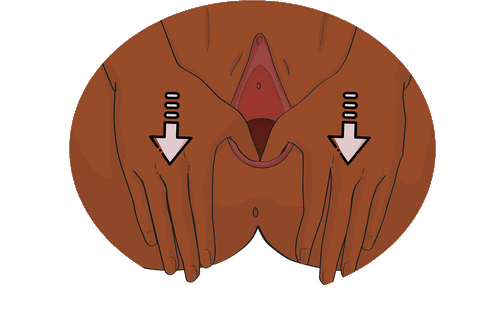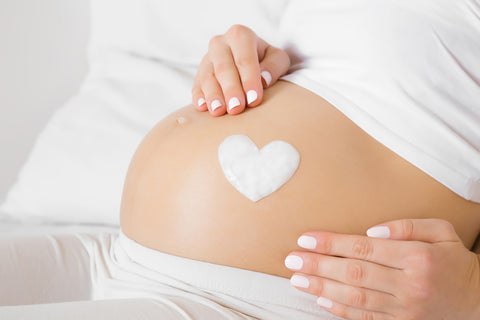
Perineal Massage & Care
Ok girls... its time to talk about perineal massage!
During a vaginal birth, around 9 out of 10 first-time mums and then 7 out of 10 mums having subsequent births will have some type of damage to their perineum.
The perineum is the skin and muscular area between your vagina and anus (your back passage) which stretches during childbirth. Damage to the perineum almost always refers to tearing and these can fall into roughly three categories;
Perineal Tear
Damage to the perineum almost always refers to tearing and these can fall into roughly three categories;
-
First-degree - to the skin of the vagina and perineum, which heals naturally
-
Second-degree - to the skin and muscle beneath, which may require stitches
- Third and fourth-degree - all the way to the anus and muscles beneath, these tend to be rare cases, the overall rate is 2.9% in the UK, slightly higher in first-time mothers.
Tears can happen for multiple reasons, mostly due to the size, position, and speed of the baby coming out and whether or not you tear is usually out of your control. However, whilst this article will focus on perineal massage there are ways you can try to reduce the extent of tearing in childbirth: .
- Avoid active pushing or the ‘Valsalva’ manoeuvre, where you hold your breath and push during the pushing stage of labour. Push when you get the urge and avoid holding your breath. Hypnobirthing techniques are good to help you learn how to breathe your baby down, especially as their head crowns.
- Give birth in any position other than on your back. Upright positions are advisable but, if you are on the bed, lying on your left or right side are good positions, too.
- Practice a simple technique called perineal massage which has been clinically proven to help make the perineum more elastic and stretch better during childbirth, therefore reducing your risk of tearing and the need for an episiotomy (a cut to the perineum, which may be recommended for medical reasons and should only be performed with your informed consent).
It is recommended to start your perineal massage routine from 34 weeks pregnant, doing it three to four times a week, for around three or four minutes at a time.
Step by Step Guide for a Perineal Massage
-
Firstly, choose a perineal massage oil you would like to use
-
Using your thumbs (or index finger if your partner is massaging), insert them into your vagina to around the second finger joint and then place your forefingers on the skin of your perineum.
-
Press downwards towards your anus and to the sides until you feel a slight burning stretching sensation. Hold the stretch for 1 to 2 minutes.
-
Massage the area between your thumb and fingers outwards and upwards and back again in a “U” shape.

With time and practice, as your perineum becomes more elastic, you will increase your ability to relax and can increase the pressure towards your rectum.
Being able to relax through this feeling of increased pressure will help you to relax as you feel the pressure in labour and your baby’s head is about to be born.
If you feel pain at any point, stop and try again another time. If you continue to and this painful speak with your midwife or GP and they will help you to check your technique.
As your pregnancy progresses you may find it easier to invite your partner to perform this for you. Perineal massage should not be painful and, with time and practice, should become effortless
Prepare your body
-
Take a warm bath or use a warm washcloth compress to soften the area (10 minutes).
-
After washing your hands, settle into a relaxed, comfortable position, bringing your knees together and towards your chest and then open your knees like a book.
-
You could also try squatting against a wall, or standing with one foot raised and resting on the bath, toilet or a chair.
-
Put a small amount of massage oil on your perineum to make the massage more comfortable. You can choose a Perineal Massage Oil from the selection on our site
Partners and Perineal Massage
Prepare to be as comfortable and relaxed as possible. This may mean adapting your environment by dimming the lights and using pillows or cushions for support.
Explain perineal massage to your partner in as much detail as possible before commencing. This will help them to understand the method required, why you are doing it and how often it needs to be done.
The easiest position for a partner to perform perineal massage is probably with you in a semi-upright position - as the diagram demonstrates - on a bed or sofa. However, it is fine to experiment with other positions, such as lying on your left or right side.
Your partner will probably find it easiest to use their fingers rather than their thumbs but, again, it is fine to try both to see what works best for you.
Once comfortable, apply some perineal massage oil on the patch of skin between your vagina and anus (your perineum). Using both hands, your partner should gently insert their index finger and middle finger on either side into the vagina, up to about the second knuckle. You may want to try starting with just the index fingers of each hand and move on to using two fingers once you feel comfortable.
Using the same method as demonstrated above, they need to move their fingers in a ‘U’ shape for a few minutes, whilst you guide them as to what feels comfortable and when to start and stop.
Preparing your perineum (the area of skin and muscles between your vagina and anus - the opening to your back passage) will help the muscle and skin to stretch more easily during vaginal birth.
If you do tear during birth, you probably won’t feel it happen – as contractions and the baby crowning are pretty intense sensations. If it’s just small tears you might not need stitches, but if you do need to have stitches, you would be given a local anaesthetic so you won’t feel them.
Perineal massage is best avoided if you have a known vaginal infection, thrush or genital herpes.
You can view our perineal care product range here



1 comment
[Please authorize this post]
Herbal remedy for Herpes,
Google [[ R o b i n s o n b u c k l e r herbal remedy ]]………………………
[Arthritis.
[Herpes.
[Love spell to get ex lover back.
[The Opioid Epidemic.
[Obesity.
[Infertility/Impotency.
[Eye Problem.
[Fibroid Tumor.
[Enlarge Prostate.
[Erectile Dysfunction….
Alice
Leave a comment
This site is protected by hCaptcha and the hCaptcha Privacy Policy and Terms of Service apply.